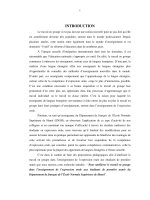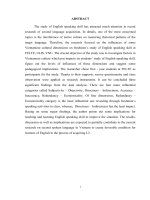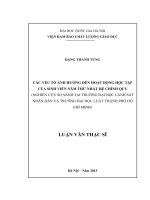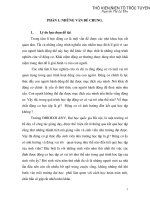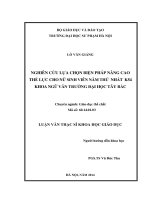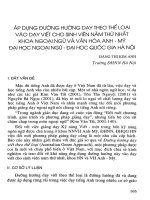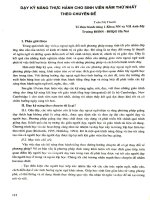Những vấn đề sinh viên năm thứ nhất Trường Cao đẳng Văn hóa Nghệ thuật Thanh Hóa gặp phải trong việc phát triển từ vựng để nói về các chủ điểm khác nhau
Bạn đang xem bản rút gọn của tài liệu. Xem và tải ngay bản đầy đủ của tài liệu tại đây (1.58 MB, 52 trang )
iii
Abstract
The importance of vocabulary is undeniable in language learning. Therefore,
understanding the difficulties faced by students in learning vocabulary is apparently
necessary to gain effective learning. This minor thesis was carried out with an attempt to
investigate the difficulties and obstacles that the first year students at Thanh Hoa College
of Culture and Arts (THCCA) have faced when learning English vocabulary.
It first described the issues which prompted the study. It then reviewed the
literature relevant to the topic of research which served as a theoretical framework for the
study. The data were collected by means of questionnaires and interviews. From that the
findings emphasized the problems influencing on the learners’ vocabulary development. In
addition, based on the findings, some solutions were suggested to improve the quality of
learning English vocabulary in speaking sections at THCCA.
iv
List of abbreviations
Clt: Communicative Language Teaching
THCCA: Thanh Hoa College of Culture and Arts
ESP: English for Specific Purposes
v
List of tables
Table 1: Criteria for selection
Table 2: Students’ purposes of learning English
Table 3: Students’ opinions about learning vocabulary for developing speaking skills
Table 4: Teachers’ effectiveness method of teaching vocabulary
Table 5: Students’ difficulties in learning vocabulary in speaking skills
Table 6: Students’ opinions about the effectiveness of teaching vocabulary in speaking
lessons
List of Charts
Chart 1: Students' habit in speaking English
Chart 2: Ss' attitudes towards the importance of speaking skills
Chart 3:
Ss' opinions about the vocabulary introduced in speaking topics in the course book
vi
Table of contents
Page
Declaration i
Acknowledgement ii
Abstract iii
List of abbreviations iv
Table of contents v
Part A: INTRODUCTION 1
1. Rationale 1
2. Aims of the study 2
3. Research questions 2
4. Scope of the study 3
5. Method of the study 3
6. Design of the study 3
Part B: DEVELOPMENT 5
CHAPTER I: LITERATURE REVIEW 5
1.1. Speaking skills 5
1.1.1. Concept of speaking 5
1.1.2. Characteristics of speaking 6
1.1.3. The role of speaking in language teaching and learning 7
1.2. Vocabulary and its role in language teaching and learning 8
1.2.1. Definition of vocabulary 8
1.2.2. Classification of vocabulary. 9
1.2.3. The role of vocabulary in language teaching and learning 11
1.2.4. Criteria for selection to teach vocabulary 12
1.3. Methodology in vocabulary teaching 13
1.3.1. The Grammar-translation Method 13
1.3.2. The Direct Method 13
1.3.3. The Audio-lingual Method 14
1.3.4. The Communicative Language Teaching (CLT) 15
vii
1.4. The role of vocabulary in speaking skills 15
1.5. Summary 16
CHAPTER II: THE STUDY 17
2.1. Research setting 17
2.1.1. An overview of the research site 17
2.1.2.
The current situation of English teaching and learning at THCCA
17
2.1.2.1. Description of the teachers of English in THCCA
2.1.2.2. Description of the students at THCCA
2.1.2.3. The learning materials 18
2.1.3. Objectives of Basic English at the THCCA 18
2.1.4. The learning of English vocabulary at THCCA 19
2.2. Methodology 19
2.2.1. Participants 19
2.2.2. Research instruments 19
2.3. Summary 20
CHAPTER III: DATA ANALYSIS AND DISCUSSION 21
3.1. Data analysis and discussion from the finding 21
3.1.1. The reality of learning vocabulary and speaking skills at THCCA 21
3.1.2. Difficulties that the first year students have faced with in learning vocabulary in
speaking skills 28
3.1.3. The solutions to the improvement of learning vocabulary in speaking skills at
THCCA 29
3.2. Summary 30
CHAPTER IV: FINDING AND SUGGESTED SOLUTIONS FOR BETTER LEARNING
ENGLISH VOCABULARY 32
4.1. Findings 32
4.2. Suggested solutions 33
4.3. Summary 35
viii
III. Conclusion 36
1. Conclusion 36
2. Limitation of the study 36
3. Suggestions for further studies. 37
REFERENCE 38
Appendix 1: Survey questionnaire i
Appendix 2: Interview iv
1
PART A: INTRODUCTION
1. Rationale
In Vietnam, the teaching and learning of English have recently gained significance firstly
because it is an international language; secondly it is also seen as a means to promote
mutual understanding and cooperation between Vietnam and other countries, especially
since Vietnam has became an official member of WTO. It has an increasing number of
people desiring to know English with the hope of keeping up with the latest modern
technology in the world. English has now been taught at all universities and colleges, and it
is considered as a compulsory subject at secondary school.
At THCCA, where the author carries out the research, English is a compulsory subject in
the curriculum. It is taught with the purpose that students have some basic knowledge of
English in order to communicate well. To achieve this aim, speaking skills should be focal
content of English language teaching. However, there still exist many difficulties facing
English language teachers in Vietnam in general and those in THCCA in particular. In
reality they find it difficult to teach speaking successfully.
Many students who have good knowledge of grammar and can do well at reading and
writing tasks but can not express themselves in spoken English. In fact, in real-life
situations, students find it hard to communicate with English speaking people.
Being a teacher of THCCA, the researcher found that one of the main reasons why students
are not positive in English is that they do not have adequate vocabulary. In fact they are
provided with almost every word necessary for their learning and their communication
outside the classroom, but for some certain reasons, these words are not appropriately used.
Many of my students complain that they learn a lot of new words, but they soon forget
most of them. There may be problems in their ways of learning vocabulary and problems
in teaching it.
2
All of the above reasons have inspired the author to carry out a research on “Problems
faced by the first-year students at Thanh Hoa College of Culture and Arts in developing
vocabulary for speaking in different subject areas” with the hope of making a small
contribution to finding out some problems students at THCCA have met with when they
use vocabulary in English speaking activities and some suggested solutions to the problems
are provided as well.
2. Aims of the study
This study aims at finding out the difficulties that the first year students at THCCA have
faced with in learning vocabulary for speaking skills. To fulfill this aim, the following
objectives are established:
+ Surveying the current learning situation at THCCA by delivering questionnaires and
interviews to the participants. Then analyzing the collected data from the participants
and evaluating the results from the surveyed data.
+ Giving some solutions to the development of vocabulary learning.
From these, the researcher tries to give some recommendations to teach vocabulary
more effectively.
3. Research questions
To achieve the objectives of the study, the following questions were raised:
1. What is the reality of learning vocabulary in speaking skills at THCCA?
2. What difficulties have the first year students at THCCA faced with in
developing vocabulary for speaking skills?
3. What techniques should be applied to improve vocabulary learning for speaking
skills?
3
4. Scope of the study
The study is limited to the area of learning vocabulary in the current learning materials for
the first year students at THCCA. This minor thesis deals with the common problems
which students have met, and basing on these problems, some effective and feasible
solutions will be provided.
5. Methodology
In order to find out the answers to the research questions, this study is to be conducted as a
descriptive study that utilizes both quantitative and qualitative approaches. The
quantitative analysis is employed through the process of data collected from written
questionnaires and the qualitative approach is used to deal with the data collected from
interviews with the teaching staff and the first year students that are fully responsible for
the teaching and learning English vocabulary in speaking sections in the learning material
“Lifeline-Elementary” for speaking skills. The combination of these data collection
methods will help ensure both reliability and validity of the study.
6. Design of the study
This study consists of three parts: Introduction, Development and Conclusion.
Part A: Introduction presents the rationale, the aims and objective, the scope, the
methods and design of the study.
Part B: Development
The development comprises three chapters:
+ Chapter I provides relevant literature concerning definition of speaking skills and
the role of vocabulary in teaching and learning speaking skills. A brief introduction of
the vocabulary teaching methods is mentioned.
4
+ Chapter II describes the methods employed in the study and introduces the
situations of learning vocabulary at THCCA.
+ Chapter III presents the data analysis discussion and offers some
recommendations for vocabulary learning at THCCA.
Part C: Conclusion
This chapter gives a brief of description of the study and
states the limitations as well as recommendations for
further research.
PART B: DEVELOPMENT
5
CHAPTER I: LITERATURE REVIEW
1.1. Speaking skills
1.1.1. Concept of speaking
Of the four skills (listening, speaking, reading and writing), speaking plays a vital role
since it is the step to identify who knows or does not know a language. Pattison (1992)
confirms that when people know or learn a language, they mean being able to speak the
language. The nature of speaking has been discussed by many scholars.
According to Brown, G. and Yule, G. (1983), spoken language consists of short,
fragmentary utterances in a range of pronunciation. There is often a great deal of repetition
and overlap between one speaker and another, and speakers usually use non- specific
references. They also point out that in speaking the loosely- organized syntax, and non-
specific words and phrases are used. Spoken language is, therefore, made to feel less
conceptually dense than written language. They also point out that the ability to give
uninterrupted oral presentation (monologue) is rather different from interacting with one or
more other speakers for transactional and international purposes. It is much more difficult
to extemporize on a given subject to a group of listeners. That explains why speaking skills
generally have to be learnt and practiced carefully before giving a presentation.
Another author examining the nature of speaking is Bygate, M. (1987), who shows that in
order to be able to speak a foreign language, it is obviously necessary to have micro-
linguistic skills, that is, to understand some grammar, vocabulary and the rules governing
how words are put together to form sentences. However, these motor- perceptive skills, as
Bygate, M. calls them, are not sufficient since while producing sentences, we often have to
adapt them to the circumstances. He then presents the second set of speaking skills: the
interaction skills, which involve using knowledge and basic motor- perception skills in
deciding what to say and how to say it, while maintaining the intended relation with others.
1.1.2. Characteristics of speaking
6
According to Bygate, M. (1985), in almost speaking, the person whom we are speaking to
is in front of us and able to give a help to correct if we make mistakes. He or she can
generally show agreement and understanding or incomprehension and disagreement as
well. Unlike readers or writers, speakers may need patience and imagination, too. While
talking, speakers need to take notice of the other and allow listeners chance to speak. It
means that we often take turns to speak.
To be more specific, Bygate (1987) assumes that conversation can be analyzed in terms of
routines, which are conventional ways of presenting information.
In Bygate’s opinion, there are two kinds of routines. They are information routines and
interaction ones.
Information routines may be described to involve two sub-routines: expository and
evaluation. The former includes description, narration, comparison and instruction. The
latter consists of explanation, prediction, justification, preference and decision.
Interaction routines are routines based not so much on sequences of kinds of terms
occurring in typical kinds of interactions. These routines, thus, can be characterized in
broad terms including the turns typically occurring in given situations and the order in
which the components are likely to occur. So, telephone conversation, interview,
conversations at parties, lessons, radio or television interviews, all tend to be organized in
characteristic ways.
In addition, learners rely on common conventional expression of communicating specific
meanings, particularly on the language environment. It is clear that practice in classroom
might not be similar to oral communication outside classroom. In a foreign language
classroom, practice is rather simple and far from real life. And it is undeniable that
speaking is a key to communication. By considering what good speakers do, what speaking
tasks can be used in class, and what specific needs learners report, teachers can help
learners improve their speaking and overall oral competency.
To sum up, in learning speaking skills, the learners can be much more confident with clear
understanding and governing the others skills. Moreover, the oral skills depend much on
knowledge of language they can learn such as grammar, pronunciation and vocabulary.
7
1.1.3. The role of speaking in language teaching and learning
From the teaching point of view, language skills consist of four macro skills: listening,
speaking, reading and writing. Those four skills have a supportive relationship.
Of all the four skills, speaking is of paramount importance, (Ur. P, 1996). It is fundamental
to human communication. Just think of all the different conversations we have in one day
and compare with how much written communication we do in one day. It can not be
denied that in our daily life most of us speak more than we write. Speaking when
compared with writing according to Wilkin (1979; cited in Nambiar 1985), is the essential
form of language and writing is ranked second after it and derived from it. About the role
of speaking, Bygate (1987: vii) points out that “It is the vehicle of social solidarity, of
social ranking, of professional advancement and of business”.
In language teaching and learning, speaking has an important part to play. It is a medium
through which much language is learnt, and which is particularly useful for learning.
According to Kayi, (2006), the ability to communicate in a second language clearly and
efficiently contributes to the success of the learner in school and success later in every
phase of life. Bygate (1987), who holds the same view, claims that our learners need to
have ability to speak confidently to carry out their most basic transactions. More than this,
speaking is regarded as the first step to confirm who knows or does not know a language.
Ur, P. (1996) indicated that people who know a language are referred to as “speakers” of
that language as if speaking included all other kinds of knowing. Consequently, a lot of
foreign language learners are primarily interested in learning to speak.
Therefore, having dealt with the importance of oral skills in language teaching and learning
it is essential that language teachers should pay great attention to teaching speaking skills
rather than leading students to pure memorization. In order to carry out many of the most
basic transactions, it is necessary for learners to speak with confidence.
8
1.2. Vocabulary and its role in language teaching and learning
1.2.1. Definition of vocabulary
It is not easy to define exactly what a word is. Up to now there have been many definitions
of vocabulary. Some linguists define it according to semantic criterion while others refer to
it according to the phonological or potential one.
According to Parmer (1983:37), the semantic unit may be a sequence of several words. For
example, “get away” is a phrasal verb consisting of two words. But the meaning of “get
away” can only be understood in the entire phrase and can not be defined by an analysis of
its parts.
According to Macmillan English Dictionary for Advanced Learners (2002:1601) defines
“vocabulary is [countable] a list of words and their meanings, especially in a book for
learning a foreign language” and “word is a single unit of written or spoken language”
According to Michael Lewis (1993:89), vocabulary “…may be individual words, or full
sentences – institutionalized utterances – that convey fixed or pragmatic meaning within a
given community.”
Ur, P (1996:75) defines vocabulary as the words we teach in the foreign language. The
author also emphasizes that a new item of vocabulary may be more than a single word; for
example, post office and sister-in-law, which are made up of two or three words but
express a single idea. There are also multi-word idioms such as call it a day, where the
meaning of the phrase cannot be deduced from an analysis of the component words.
Therefore, a useful convention is to cover all such cases by talking about vocabulary
“items” rather than “words”
Meanwhile, in spite of the fact that many scientists talked about linguistics, the notion of
word, they did not give any definition of word on their own. According to Quirk (1974),
“Thinking of word comes to us so naturally that takes a serious effort to realize what
miraculous devices they are. Like so many other things that are basic and elemental in our
lives, we take them for granted and we are surprised to find how hard it is to say exactly
what a word is”.
9
In short, it is possible to say that it is hard to give a precise definition of word. For the
pedagogical purposes of this paper, the definition by Ur, P. (1996) is used.
1.2.2. Classification of vocabulary
There have been different ways to classify vocabulary according to different criteria.
(i). In terms of the concept of morpheme.
Vocabulary is divided into three kinds: simple words, derived words and compound words.
Simple words consist of a roof morpheme, such as big, hat, etc.
Derived words consist of a roof and one or more derivational morphemes like player,
interesting, etc.
Compound words have at least two roofs with or without derivational morphemes. For
example: plant-eater, racing horse, etc.
(ii). In terms of the meaning
There are two main kinds of meaning in a word: lexical meaning and grammatical
meaning. Therefore, vocabulary can be divided into notional words and functional words.
Notional words are words with clear lexical meaning. They address objects, actions,
qualities, etc. and they have meaning in themselves. Notional words form a great number
of each speaker’s vocabulary.
Functional words are words whose meaning is grammatical and only have meaning in
relation to the other words with which they are used. Functional words are particles,
articles, prepositions…
(iii). In terms of the function of vocabulary items in a sentence.
According to the function of vocabulary items in a sentence, vocabulary can be divided
into parts of speech: nouns, verbs, adjectives, adverbs, prepositions and pronouns. Each
part of speech has its own position complying with certain grammatical rules and relating
to others.
10
The teacher should point out the function of each item so that students can use its
grammatical rules correctly.
(iv). In terms of the use of word.
According to this criterion, vocabulary is divided into active words and passive words.
Active words are defined as “words which students will need to understand and also use
themselves.” (Doff,1988:19). In teaching this type of vocabulary, it is necessary that
teachers spend time giving examples and asking questions to check students’
understanding. Teachers also need to show the students the possible contexts where these
words can occur so that students know how to use them appropriately and effectively.
Active words are vital for the productive skills such as speaking and writing.
On the other hand, passive words are characterized as “words which we want students to
understand (e.g. when reading a text), but which they will not need to use themselves.”
(Doff,1988:19). Therefore, teachers only present passive items quickly with simple
examples or leave them for the students to guess from the context. Passive words are
especially useful for receptive skills of reading and listening.
Therefore, the teachers should spend more time teaching active words to help them
understand and use them correctly and naturally.
1.2.3. The role of vocabulary in language teaching and learning
Vocabulary has an important role in each language, because "words are the tools we use to
access our background knowledge, express ideas, and learn about new concepts" (Texas
Reading Initiative: 2000: 4). So that the first thing we do in learning a new language is
learning vocabulary of that language.
“Vocabulary is one of the three dimensions of a language (phonetics, grammar,
vocabulary). Without grammar very little can be conveyed, without vocabulary nothing
can be conveyed.” (Wilkins,1972:111). The statement indicates the great importance of
vocabulary. Since vocabulary is so important, teaching and learning vocabulary should be
paid much attention to. The main objective of language learners is to understand and be
11
understood in their communication using the language acquired. In order to achieve this
aim, they have to study a certain number of vocabulary items. If someone has adequate
vocabulary, he or she will feel more confident when communicating with others as well as
expressing his/her opinions in both spoken and written forms. Regarding to this matter,
Wallace (1982) said: “Failure to find the words one needs to express himself is the most
frustrating experience in speaking another language”.
It is clear that mastering the meaning and especially the use of a word has an important
role in learning a foreign language in general and in learning English in particular. If
someone misuses words, people will misunderstand him. If someone can use correct
grammar but does not have appropriate words to express his opinion, it is quite hard to
build up a successful conversation. The more words he knows well, the more successful he
is in communication and the more information he can get from different sources such as
books, magazines, newspapers, etc. In other words, a good knowledge of vocabulary will
help learners develop the four language skills: listening, speaking, reading and writing.
Therefore teaching and learning vocabulary are significant in learning a foreign language,
especially in the light of communicative approach.
In short, in learning a language, the importance of vocabulary couldn’t be helped
mentioning. In order to succeed in learning a language, it is very essential for learners to
master its vocabulary.
1.2.4. Criteria for selection to teach vocabulary
When making decisions about content, one of the first questions the language teachers will
have to address is what vocabulary to teach. For many of them this will be determined by
the choice of the course book, the syllabus designers, or other factors. Even so, the
teachers should be concerned about the different criteria used when designing their
syllabuses and materials, the ones followed in making decisions about vocabulary content
in language courses, and what the objectives of these particular decision are. Otherwise, it
becomes difficult to evaluate syllabuses and materials, to understand why particular
vocabulary is to be taught as well as to explain to learners why they must learn particular
words (Mc Carthy 1990:79)
12
Now different criteria can be employed to select the particular words to be taught.
Teaching can effectively deal with only a small amount of information about vocabulary
items at a time. Thus, teachers have to take into considerations factors. The criteria which
may be used to select vocabulary are as following table (cited from the website:
).
Criteria
Order of importance
Definition
Frequency
1
Average number of occurrences of a word in a
language
Range
2
A measure of the different types of texts in
which a word occurs
Language needs
3
The words that are regarded as 'require' by the
learner in order to communicate
Availability and
familiarity
4
The word the learner is mostly in contact with
and somehow ' know'
Coverage
5
the capacity of a word to take the place of other
words
Regularity
6
How is the use of a word 'spread' over the
language
Learnability
7
Are some words easier to learn than other
Table 1: Criteria for selection
1.3. Methodology in vocabulary teaching
According to Mackey (1971), “The method used has often been said to be the cause of
success or failure in language learning; for it is ultimately the method that determined the
what and the how of language instruction”. In recent years, foreign language teaching has
undergone many dramatic changes. In order to understand the scope of the subject,
language teachers should have a clear perspective on the developments of language
teaching approaches as well as their interrelationship between developed one. Teachers
should make appropriate decision on objectives of which approaches for the teaching
situation. Following is a brief presentation of some major foreign language teaching
methods and their application in the vocabulary language teaching.
13
1.3.1. The Grammar- translation Method
According to Davies (2000:188) “This method is arose out of the traditional teaching of
classical Latin and Greek, when living language began to be widely taught in the
nineteenth century”. In general language teaching, the classes are taught mainly in
Vietnamese, with little active use of English. On regard of teaching vocabulary, much of it
is taught in the form of lists of isolated words. Then students are expected to study and
memorize that list of vocabulary together with their translation equivalents in the mother
tongue. And the grammatical rules and paradigm are given to put words together. Besides,
the method aims at providing the rules with wide literary vocabulary in written exercises.
Teachers also find it an easy and quick way to explain the meaning of words.
In this method, the teachers' role is to explain grammatical rules, and the list of vocabulary
and its meaning in Vietnamese to help students to do the written exercise in grammatical
analysis, not the exercises in the context of text. This method can be classified as mental
discipline and is easy to apply and simple to test and to control.
1.3.2. The Direct Method
According to Davies (2000:189) “This method developed as a revolution against the
Grammar-translation Method at the end of the nineteenth century. It was based on some
extent on the new sciences of the nineteenth century, especially linguistics and
psychology”. According to this method, new teaching points are taught through modeling
and practice. This means that the second language learning should be treated as the first
language learning. During the process of teaching and learning, only the target language is
used, no mother tongue is allowed. This method requires no translation between first and
second language, little or no analysis of grammatical rules. Besides, it lays an emphasis on
correct pronunciation and grammar.
From his point of view, this method is very useful for teaching vocabulary, the teachers
introduce through objects and pictures. The words used are very common, active and
concerning daily activities. By this method, concrete vocabulary is taught through mine,
14
demonstrations and pictures while the meanings of abstract words are made clear by
association of ideas.
1.3.3. The Audio-lingual Method
This method grew indirectly out of a program developed by American linguists and
psychologists for the US Army during the Second World War. According to Davies
(2000:190) there are two of the main activities of the Audio-lingual Method that are
dialogue repetition and memorization, and substitution drilling. The dialogues are often
little more than vehicles for pronunciation practice with a few contextualized models of
the new structure. The substitution drilling is often uncontextualized manipulation of
structure. To carry out teaching vocabulary, some common techniques are exploited such
as repetition drill, single slot substitution drill use of minimal pairs, etc.
With such kinds of practice, students will have better memory of words, terms and phrases
and know how to use them practically. This way of teaching makes the class more active
in learning and the teacher more creative in teaching.
1.3.4. The Communicative Language Teaching (CLT)
This approach grew out of the new theories of language and language learning that
developed in the 1960s and 1970s in Britain, the USA and elsewhere, as well as new
classroom procedures. It is an outcome of more attention to learners’ effective and
appropriate use of language learnt. It is probably the approach most used by trained
language teachers today. In this approach, vocabulary will be learnt through
communication, through interaction in the target language and through enhancement of the
learner's own experiences as important contributing elements to classroom learning and
through an attempt to link classroom language learning with language activation outside
the classroom. Communicative activities inevitably mean that the teacher relaxes control
over what the learners hear, say, read, write and think and so the learners have to take
some control over their own learning.
15
In CLT, students become more confident when communicating with one another and
become more active in class. So that CLT is generally considered essential for success in
language learning.
1.4. The role of vocabulary in speaking skills
English is used as a communicative tool between two or more people who come from the
different countries so the use of English will require much vocabulary. Needless to say, a
person who has much vocabulary will find it easier to master English than any other person
who does not. With much vocabulary people can also be more proficient in
communication, because they do not need to be worried when selecting the words that will
be used in conversation. From this, we can say vocabulary and communicative ability are
highly correlated. Lewis’s point of view is quoted to support this: “Vocabulary is a basic
tool in communication. If acquires do not recognize the meaning of key words used by
those who address them they will be unable to participate in the conversation. If they wish
to express some ideas or ask for information they must be able to produce lexical items to
convey the meaning. Indeed, if our students know the morphology and the syntax of an
utterance addressed to them, but do not know the meaning of key lexical items they will be
unable to participate in the conversation” (Lewis, 1993:115).
To sum up, building vocabulary is such an important aspect of learning a foreign language.
The shortages of vocabulary impact on the difficulty of using English properly in spoken
and written forms. Hence, no matter how interesting speaking activities are, student
participation may be discouraged by their limited words. The more words learners know,
the more they can communicate. If students can make good use of new words, it is likely
their vocabulary will be improved as well as their speaking skills. That is the reason why
providing vocabulary input should precede any speaking activities.
1.5. Summary
16
In this chapter, a brief description of the theoretical knowledge relating to the study was
provided. It included definitions of speaking skills and vocabulary and their roles in
teaching and learning English. This chapter also included a short discussion of vocabulary
teaching methods and these issues served as a theoretical and methodological foundation of
the study.
Chapter II: THE STUDY
This chapter starts by describing the situation where the study is conducted. It includes an
overview of THCCA, the teachers of English, the students, the textbooks, the current
teaching and learning situation. The subjects and the method of data collection are also
17
discussed in details. At the end of the chapter there will be the analysis of the data
collected from the survey questionnaires and interviews that will be expressed as a
percentage in the form of tables.
2.1. Research setting
2.1.1. An overview of the research site
Thanh Hoa College of Culture and Arts was set up 20 years ago. Its duty is to train
teachers of Art and Music, Tourist guides, Office Secretaries.
Every year the college admits more than 500 newly enrolled students for a course of 3 year
study. Almost of them hope to become tourist guides, culture managers or secretaries and
the others hope to become teachers of Fine Arts or Music. English is considered as the
compulsory subject in the course syllabus with the purpose of helping the students to
develop their English communicative skills to meet the demand for their future
employment. So Basic English is chosen for providing basic knowledge about grammar
and vocabulary to the first year students.
2.1.2. The current situation of English teaching and learning at THCCA
2.1.2.1. Description of the teachers of English in THCCA
There are 8 teachers of English aged between 25 and 35. They all have had at least three
years of teaching experience. They are responsible for both Basic English and ESP. They
enjoy teaching and spend all of their enthusiasm and effort making their teaching lessons
interesting and attractive to the students.
2.1.2.2. Description of the students at THCCA
Most students of THCCA have come from all parts of Thanh Hoa province. These
students commonly spent most of their time to learn three subjects: literature, history and
geography in order to pass THCCA entrance exam. So, they are real beginners at English
when entering the first year of college. Some of them have learnt English for 7 years at
secondary and high school and some have only learnt English for 3 years in high school
18
and others have learnt French and Russian. Students from Thanh Hoa City and towns (Bim
Son and Sam Son) seem to be better at English. However, in reality, during the years at
secondary schools as well as at high schools, these students were taught under the strong
influence of the old methods, which emphasized on learning the grammatical rules not on
the acquisition of language skills. Therefore, it is necessary for teachers to find out the
different ways to draw their students’ interest in English speaking, preventing them from
being bored with the subject. Students need to have various opportunities to practice their
speaking skills with using vocabulary appropriately in an encouraging learning
environment.
2.1.2.3. The learning materials
The course-book Lifelines – Elementary written by Tom Hutchinson, which is designed for
developing all four skills. This course-book is divided into fourteen units, each of them has
been divided into five parts in which vocabulary part aims at providing students with new
vocabularies in different topics, and these topics are used in the related parts of the units.
After every two units there is an “extension” section accompanied with two class cassettes.
The work-book contains additional grammar practice, vocabulary, and functional language
from the student's book and five “grammar check” revision sections.
2.1.3. The objectives of Basic English at the THCCA
Students study Basic English in just two first semesters. The objectives of Basic English
teaching program at the THCCA are to help the students read, speak and understand simple
written English language materials, use vocabulary and structures appropriately to give
instructions, enable to express themselves orally using simple English language, use the
basic structures of English sentences. Furthermore, they can appreciate the importance of
English language as an international language communication to benefit from the
achievements of other cultures.
2.1.4. The learning of English vocabulary at THCCA
19
It can be seen that communication is the goal of English language learning. Its purpose is
to help students develop their communicative competence. This makes learning vocabulary
for speaking skills to be an important part in any English course. Like many other high
schools in Vietnam, learning vocabulary at THCCA are affected by some constraints of the
course, students’ low English proficiency, students’ low participation in class. All the
above factors make the learning vocabulary more challenging.
The major concerns of this research are how to overcome the problems and improve the
quality of learning vocabulary at THCCA.
2.2. Methodology
2.2.1. Participants
In order to get information for the study, a survey questionnaire and interview were
designed. The questionnaire was administered to 90 first year students of 2 faculties
(Tourism and Culture) at the college. They aged from 18 to 22 years old (25 males and 65
females). They all learnt English at secondary and high schools. The questionnaire was
delivered to students to investigate the challenges they had faced with in learning English
vocabulary at THCCA and their expectations from the textbooks as well as from the
teachers. The questions were interviewed one on one three students chosen randomly to
identify the difficulties they have faced with in learning English and provide them with
some solutions to the problem.
2.2.2. Research instruments
The collecting instruments were questionnaire and interview for the first year students to
identify their difficulties in learning vocabulary in developing speaking skills. Both of
survey questionnaire and interview were only used as the instrument because of its
convenience and the limitation of scope of this study.
Survey questionnaires for students
The questionnaires for the students were designed with two main parts in Vietnamese.
